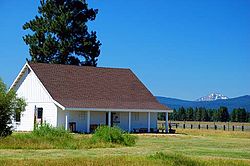| Fort Klamath | |
|---|---|
| Klamath County, Oregon | |
 Fort Klamath guard house | |
| Site information | |
| Type | Military base |
| Controlled by | United States Army |
 | |
| Site history | |
| Built | 1863 |
| In use | 1863–1890 |
| Materials | wood |
| Battles/wars | Modoc Wars |
| Garrison information | |
| Past commanders | Edward Canby |
| Garrison | 14th Infantry Regiment |
Fort Klamath Site | |
| Nearest city | Fort Klamath, Oregon |
| Coordinates | 42°41′31″N121°58′20″W / 42.69194°N 121.97222°W |
| Built | 1863 |
| NRHP reference No. | 71000680 [1] |
| Added to NRHP | October 07, 1971 |
Fort Klamath was a military outpost near the western end of the Oregon Trail, between Crater Lake National Park and Upper Klamath Lake in Klamath County, Oregon, United States. The Fort Klamath Site, about a mile southeast of the present community of Fort Klamath, Oregon, is listed on the U.S. National Register of Historic Places

